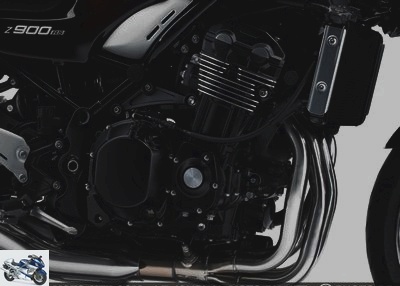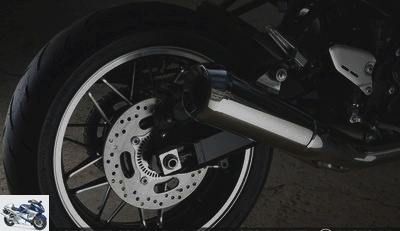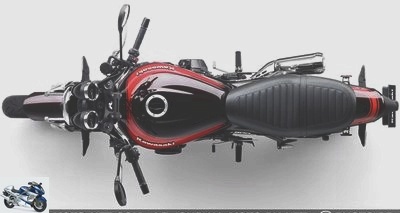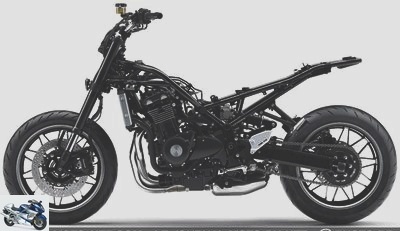Z900RS test: the new neo-retro Kawasaki Zed, zen and zealous

Kawasaki is back in the neo-retro segment with a brand new motorcycle: the Z900RS! Site was able to take control of this novelty 2018 which pays tribute to the famous Z1 of the 70s. Direction Barcelona (Spain), its sun and its pretty roads … Test drive.
Z900RS test page 3 – Technical point
Engine
Developed in parallel, the Z900RS and the "short" Z900 share the 948 cc (73.4 x 56 mm) 4-cylinder liquid cooled, dual overhead camshaft and 16 valves (29 mm intake side, 24 side exhaust), duly Euro4 approved. But the two engines differ in many ways…
The camshafts of the Z900RS in particular, have been calibrated in order to reinforce the low and mid-speeds: the intake and exhaust opening times have been reduced, respectively from 270 to 248 °, and from 256 to 244 °. On the intake side, the ramps have been redesigned to reduce noise.
The compression ratio drops by one point to 10.8: 1. At the same time, the engineers placed a flywheel heavier by about 12%, in order to underline the at the same time strong and soft character which was to have their new motorcycle at the same time modern and at the same time classic..

In the end, the maximum power goes from 125 hp at 9500 rpm on the roadster to 111 hp, 1000 rpm lower, on the Retro Sport. The maximum torque for its part, only loses a tenth in the operation: 98.5 Nm from 6,500 rpm on the RS, against 98.6 Nm at 7,700 rpm on the Z900.
The Z900RS retains pistons produced by a specific casting process, initiated on and, to match the weight of forged pistons. The channels between the cylinders are maintained in order to reduce the losses of power by "pumping".
Likewise, a secondary balancing shaft, driven by a pinion mounted on the sixth weight of the crankshaft, is always responsible for reducing excessive vibrations and keeping the good ones! An additional modification ensures a great comfort of use at high speed…

The Z900RS indeed pulls longer than the Z900: the rear wheel crown loses two teeth (42 therefore, 15 still at the pinion) and the sixth report is also lengthened (29/30 on the RS, against 30/29 on the roadster). When the Z900RS trots at 90 km / h for example, the tachometer needle indicates a small 3500 rpm.
In order to keep good starts at the light – green like a Kawa! -, the first gear is shortened on the contrary (35/13 Vs 35/12). "The large torque available from the lowest revs avoids stalling when starting", guarantees the Akashi firm.
The 4-in-1 exhaust was specially made for the Z900RS: the diameter of the inner tubes have been considerably reduced (from 35 to 28.6 mm!) In order to boost the low revs precisely. The outer tubes are the same section as those of the Z900 (38.1 mm).

To ensure a sufficiently classic look, the collectors are not interconnected. After a long hesitation, the engineers decided to mount a compact "megaphone style" silencer. According to Kawasaki, the Z900RS would be the first model to benefit from an extensive study with regard to the tone of its pot. On the previous Z1000 and Z900, the intake noises had been more worked.
Japanese designers have also worked on the mill … water! The presence of the radiator does not fool anyone, but the polished fins, the smooth casings, the black tint and the aluminum parts all the same refers to the 900 Super Four of the Z1 launched in 1972 in pursuit of the CB750 Four….

Like the Z900, the RS incorporates an assisted anti-slip clutch. As a reminder, it incorporates two types of cam: an assistance and an antidribble, hence its name! The first cam appreciably softens the operation of the lever, the second prevents that the rear tire does not dribble or skid during a too abrupt or involuntary downshift.
The gearbox has six reports: five rather close to promote acceleration and relaunching, and a sixth qualified as "overdrive" by the manufacturer which allows cruising on the motorway at 140 km / h (odometer!) Without too much milling. ‘gear (just above 6000 rpm).
Cycle part
In order to accommodate the teardrop tank, the front part of the Z900RS frame is narrower than that of the more "generous" Sugomi style Z900. The steering angle takes the opportunity to increase by 2 ° (35 ° / 35 ° therefore). To respect the lines of the Z1 to the end, the rear loop of the Retro Sport is much more horizontal than on the Z900.
The saddle height increases by 4 cm: the seat of the Z900RS is therefore 835 mm from the ground. The big ones welcome it because they can relax their legs. The little ones, on the other hand, will have to consider the purchase of the low saddle located at 800 mm.
According to the learned calculations of the little green men, the handlebars are at the same time 30 mm wider, 65 mm higher and 35 mm closer to the rider. At the same time, the footrests have migrated 20mm forward and down. MNC confirms that the driving position is more relaxed than on the "streetfigther" Z900…

As on the roadster, on the other hand, the engine of the RS is secured to the frame via five rigid supports: "at the front and at the rear of the cylinder head, behind the cylinder block as well as at the top and bottom of the crankcase engine ", specifies Kawasaki … who will have taken care to strengthen the fixing holes of the shock absorber rod !
Extremely visually close to that of the roadster, the RS’s extruded aluminum swingarm weighs exactly the same weight (3.9 kilograms). The shock absorber, adjustable in preload and rebound, is always mounted horizontally, "Back-link" style, via a set of rods.
In front, the inverted fork of 41 mm gains a compression adjustment, in addition to the preload and rebound with which the owners of the Z900 "Tout court could already play. If the frame angle of 25 ° is preserved, the frame is slightly reduced (98 mm).

The spoked rims were not retained on this motorcycle which wishes to ingeniously mix modernity and classicism … The designers therefore equipped it with extremely thin spoked wheels which, MNC must emphasize, make a very good impression, especially when ‘they are polished (orange / brown biton models only …).
To reinforce its motorcycle image not only on the page but also "Premium", the Z900RS receives a pair of radial-fixing 4-piston calipers which bite the 300 mm discs with the classic cut (round, not "with petals ").
The single 250mm rear disc – also quite round – is clamped by a single piston caliper. The ABS system is again entrusted to compatriot Nissin. The tires are still supplied by Dunlop: specific D214 "Z" are fitted as standard on the Z900.
Instrumentation
The Z900RS ‘homage to the first "Zed" in history can be seen from the "Ducktail" shaped rear shell to the handlebars where instrumentation is as classic in shape as it is modern in content and handling..
The two large bullet-shaped counters take the typography, scales and needle angles of those of the original Z1! On the one on the right, the Japanese went so far as to indicate the same maximum speed: 240 km / h, which Site did not have the opportunity to reach..

Between the tachometer and the analog tachometer is a digital window presenting rudimentary information (fuel level and engine temperature), practical (gear indicator light engaged, KTRC 1/2 / Off, odometer, partial trips, time and range remaining) and secondary (average and instantaneous consumption, outside temperature).
The on-board computer and traction control share the same control placed on the left of the handlebars, above the turn signals and hazard lights – or back up more often … Scroll through the info and juggle between modes 1 and 2 of the KTRC is childish, so you don’t have to take your eyes off the road. Only disconnecting the traction control requires a complete stop of the machine.
Related articles
-
Z900RS test: the new neo-retro Kawasaki Zed, zen and zealous Kawasaki is back in the neo-retro segment with a brand new motorcycle: the Z900RS! Site was…
-
2020 Z900 test: Kawasaki returns to its Nine-without-aids Successfully launched in 2017, the Kawasaki Z900 evolves in 2020: the roadster changes music…
-
2020 Z650 test: the Kawasaki roadster not all new but all beautiful ? Launched in 2017 on the competitive medium-displacement roadster market, the…
-
Yamaha Niken test: trying the three-wheeled motorcycle is taming it ! For more than ten years, Yamaha engineers have been racking their brains to offer a…
-
Which A2 motorcycle to choose from Kawasaki? Test of Z900 70 kW, Ninja 400 and company… In 2018, Kawasaki launches two new motorcycles compatible with…
-
Roadster – Yamaha MT-09 SP test: the one we SPEED! – MT-09 SP test page 3: Technical point
Yamaha MT-09 SP test: the one we Sought ! The Yamaha MT-09, one of the stars of the French motorcycle market, never ceases to enchant bikers eager for…
-
Ninja 650 test: Kawasaki camouflages its road in sport In 2017 Kawasaki introduces a new Ninja! Not a pistarde just approved for the road, but the…
-
Kawasaki Z125 and Ninja 125 test: for generation Z or ZX-R bikers ? Unveiled in September, the Z125 and Ninja 125 land in mid-December in dealerships….
-
2019 Katana test: new fit for the Suzuki maxiroadster Suzuki is making a daring bet on the roadster segment in 2019 by launching a new Katana. A…
-
Z900 test: the new Kawasaki roadster without aids ! True to form, Kawasaki has decided to replace its popular Z800 with a beefier Z900: larger engine,…